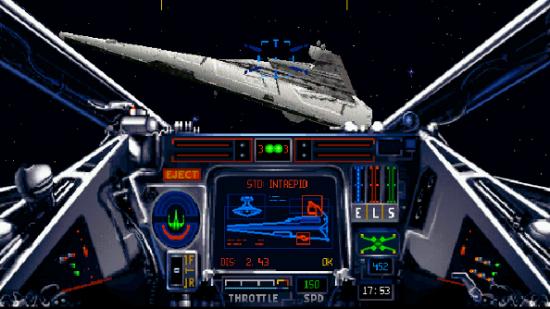With the release of the Collector’s CD-ROM Editions of TIE Fighter and X-Wing on GOG, I figured it was time to revisit this post and play one of the best Star Wars PC games. Some of my advice has changed, and I’ve also had to troubleshoot another joystick problem with TIE CD.
But the most important thing to know is that the definitive version of TIE Fighter is now available and you must play it.
Now which versions should I play?
The X-Wing Collector’s CD-ROM doesn’t offer much over the original game. Even at the time, it was outdated as it was being released. I’ve played quite a bit of the X-Wing 1998 reissue and find it superior in every way, so it gets a hearty recommendation.
However, when it comes to TIE Fighter, the CD-ROM version is really the only way to go. It’s got all the expansion campaigns, and it uses the original flight model and not the slightly different flight dynamics of the 1998 reissue. More importantly, it uses the original MIDI score, which changed to match what was happening in each mission, which is what a musical score is supposed to do. So instead of having orchestral renditions of the John Williams score blasting 24/7, you’ll have the music get thoughtful and moody when you’re waiting for something to happen, triumphant when you have completed a mission objective, and frantic when you’re dogfighting.
But first we have to deal with a weird error I had with TIE CD’s joystick support.
What to do if your joystick won’t calibrate.
This was infuriating. When you launch TIE CD, you’re prompted to calibrate your joystick. But when I tried to do so, the game would not register any of my button-presses. I could use the DOSBox control panel to map my joystick as “joystick 2”, but that only succeeded in crashing the game whenever I touched a button.
The trick, then, is to ignore the first calibration screen. Just click through it with your mouse. When you get into a mission, however, after the engine loads you can hit ALT+C and it brings up the in-engine calibration window. That should work.
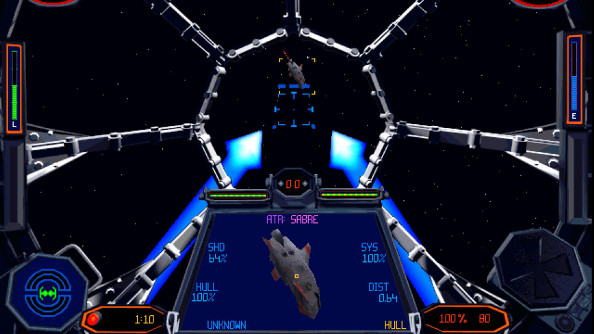
Why can’t I play TIE 98? I like the graphics better.
I didn’t appreciate this at the time of the re-release, but TIE 98 is actually kind of broken. The problem is simple: when they ported everything into the X-Wing vs. TIE Fighter engine, they upgraded concussion missiles to Advanced Concussion Missiles. So early in the campaign, instead of firing the regular missiles, enemies fire the ACM.
The ACM, in X-Wing vs. TIE Fighter was a doomsday weapon. One hit will knock out fully-charged shields. If your shields are damaged, a hit will destroy you. It’s also incredibly hard to dodge and, in some fighters, it’s essentially impossible. So the difficulty of all the missions gets screwed-up in the 98 version. X-Wing 98 doesn’t seem to have this problem.
X-Wing 98 keeps crashing at mission start!
Whatever you do, don’t turn on hardware acceleration. That doesn’t work correctly and crashed my game every time.
Old article
Now that I’ve had a day with the new TIE Fighter and X-Wingre-releases on GOG, there are a few issues that I’ve encountered and a few things I’ve learned about the editions available on GOG.
Most importantly, I had an odd and frustrating joystick issue that took me a few minutes to solve.
In order to play the 1998 versions of X-Wing and TIE Fighter, you absolutely have to have a joystick. There are supposedly some workaround out there to fake it with a mouse and keyboard or a 360 controller, but the particular problem I had was that the game did not recognize my perfectly good Saitek X-52. Every time I launched the game, I got an error message telling me to make sure my joystick was connected.
My first thought was that the GOG editions were having trouble with USB joysticks, and that I’d have to find some kind of emulator to trick the program into thinking I had a serial port joystick.
But actually, it turns out the “advanced” tab in the USB game controllers offers an option about which of your USB devices you’d like to use for older games. For some reason, Windows had decided my USB webcam was also a joystick, and that is what it was trying to use for TIE Fighter.
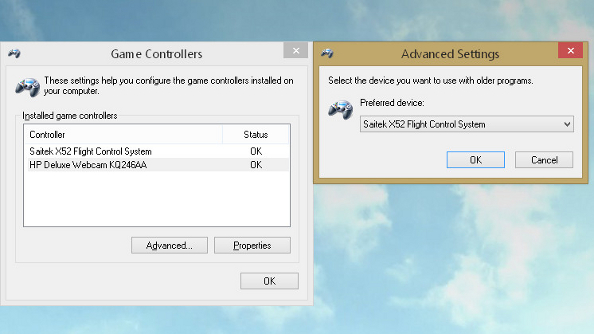
So, if you have a USB joystick and it’s not behaving with TIE Fighter or X-Wing, just make sure you have the right device selected in the “Set up USB Game Controllers” menu. Once I’d taken care of that, both the 1998 and original 1994 editions worked with my joystick.
Oh man, do I NEED a joystick to enjoy these games?
To play the more modern versions, you do. But the original versions worked quite well with mouse and keyboard, though it can be hard following more maneuverable craft by throwing your mouse around.
What surprised me, honestly, was just how good the joystick controls are for X-Wing and TIE Fighter. After years of playing games like MechWarrior Online, in which the joystick controls are simply not competitive with mouse and keyboard, or War Thunder and World of Warplanes, which require tons of tuning in order to get an adequate joystick experience, I’d started to lose faith in my trusty flight stick. Maybe joysticks weren’t as good as I remembered?
Nope. They’re amazing. It’s just that developers stopped viewing them as a primary control input, and started optimizing for other control schemes at the expense of the joystick and throttle. TIE Fighter and X-Wing offer about as much precision with a stick as with a mouse, and a hell of a lot better maneuverability. It’s been ages since I played a twitchy game that was so perfectly tuned for a flight stick, and it’s proving to be a revelation.
So you probably want a joystick.
OK, but what joystick should I get?
Good question, and one I’m trying to answer for myself.
See, my Saitek X-52 perished after just one afternoon of TIE Fighter. It’s about seven years old, so it was probably due for retirement. But that leaves me with a dilemma about what stick I’m going to buy to replace it.
If you’re just dipping your toe in the water of space sims, and want something that makes you feel like you’re Wedge Antilles without breaking the bank, then the answer is pretty straightforward: the Thrustmaster T-Flight HOTAS X. It’s a stick that gives you just enough control and versatility to enjoy flight sims and other space games, but it’s only about $50. It wouldn’t please a serious sim enthusiast, but it’s probably the best and most versatile entry-level stick out there. Plus, Thrustmaster have been making these things for ages and their build quality is some of the best around.
Above that level, things get more complicated.
Saitek’s replacement for the X-52 model is the X-55 Rhino, and at $200 with a dual-throttle control and an attractive military-style flight stick, it looks like the perfect purchase. The problem is, this stick has also been dogged by complaints about manufacturing quality. Across a number of sites and threads, it looks like a significant portion of X-55s have either been defective or dead-on-arrival.
Since it comes with a warranty, that may not be a deal-breaker. If you have the time, you can pester Saitek / Mad Catz until you get one that performs up to spec.
But based on my own X-52, which always had issues with calibration and a weirdly loose flight-stick, I’m not so sure that’s good enough. It’s certainly not a stick I could ever recommend without a lot of caveats, and the X-55 sounds like it has some of those same issues. The poor build-quality complaints don’t inspire much confidence.
The thing is, the king of the flight sticks right now is $450. Thrustmaster’s Warthog controller is basically ripped out of an A-10 cockpit and planted on your desktop. I have yet to hear a bad word spoken against this stick but… $450. This is a stick you buy if sims are going to be playing a big part in your life. But if you just want to bust some X-Wings, it’s overkill.
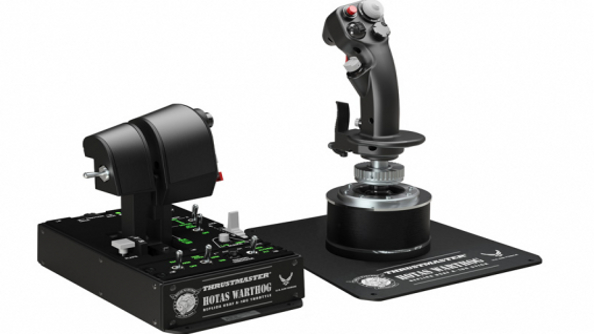
And if you’re a lefty who has trouble with right-handed sticks, Thrustmaster has you covered. But unfortunately, most every throttle-and-stick combination is built for right-handed pilots.
So which version of TIE Fighter and X-Wing should I play?
So, in my original post I was a bit disdainful toward the 1998 versions. But having spent some time with both editions of TIE Fighter, I find myself gravitating towards the 1998 version rather than the original [Edit: Not anymore! Get with TIE CD on GOG!].
It’s not just about the graphics, although there’s no denying that the old VGA graphics look pretty godawful on a 27 inch 16:9 monitor. I’m also having a slight but noticeable framerate hitch playing the 1994 edition. Most of the time it’s perfectly smooth, but every thirty seconds or so, there’s a jump. It’s the pretty annoying in the middle of a tense dogfight, I have to say.
The main issue, however, is that the One True Version of TIE Fighter was the Collector’s CD-ROM version that came out a year or so after the original. It offered a much higher resolution, an extra campaign, and a lot of good voice acting for various Imperial officers. The original version, which was published on 3.5” floppy disks, had no such luxuries.
So as things stand now, you face a pretty stark choice between the original version, which has almost no flashy bells-and-whistles whatsoever, or the 1998 edition, which employs a slightly different flight model but also has a lot of the elements that gave TIE Fighter such a distinctive flavor. Since I consider that flavor an indispensable part of TIE Fighter, I’m playing the 1998 version.
For X-Wing, those difference are less important, since the X-Wing Collector’s Edition was a less impressive package. But that game needs all the help it can get, as I’ll explain below.
Should I play TIE Fighter or X-Wing first?
Oof, this is a tough one.
X-Wing really is more like a prototype next to TIE Fighter. The missions design is nowhere near as sophisticated, and there’s a bare handful of units next to TIE Fighter. TIE Fighter is the masterpiece, and X-Wing is really just its predecessor. Even if you do think X-Wings and A-Wings are cooler, they just don’t star in nearly as good a game.
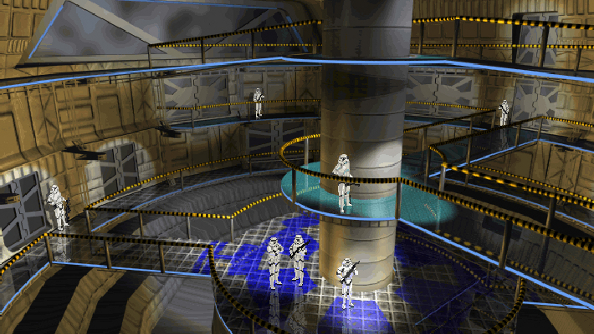
BUT: you might want to start with X-Wing if you don’t have that frame of reference. Going from TIE Fighter to X-Wing is a big comedown, so you might get more use out of these re-releases if you start with X-Wing.
This game seems really complicated. I just want to shoot down enemy spaceships.
It’s really not complicated, but the X-Wing and TIE Fighter games definitely come from more of a sim tradition than an arcade tradition.
However, you don’t NEED to know all the commands. In fact, there’s only a handful you’ll need for most of the game.
Targeting is probably the trickiest part of the game, especially as battles get more and more chaotic. Still, these basic commands cover 95% of your needs.
R: target nearest enemy fighter.
U: target newest ship (frequently, the new arrivals are important to your mission)
T: next target
Y: previous target
At their heart, both X-Wing and TIE Fighter are about energy management. By default, your weapons don’t recharge and you can basically run out of power for your lasers. But setting those systems to recharge reduces power to the engine, slowing you down. And in a dogfight, speed is life.
I recommend keeping your power at normal and only recharging when you are safe or you are low on power. Most of the time, you’ll want that extra speed.
F9: change weapon recharge rate.
F10: change shield recharge rate.
Speaking of speed:
Enter: Match speed to target (critical, especially when engaging slower targets)
Backspace: full speed
Your wingmen are terrible. Still, they are good for catching laser shots and keeping the bad guys distracted. Here is what they are best at.
Shift-C: Tell wingman to protect you
Shift-A: Tell wingman to attack current target
Some ships have missile launchers in addition to lasers. You might also want to sacrifice fire-rate for larger salvos of multiple shots at a time.
W: change weapons
X: change fire mode
And that’s basically it. Twelve commands and you’re mostly ready to do battle.
I feel bad playing the Empire.
Don’t. TIE Fighter makes a persuasive case for the Galactic Empire. Yes, they wiped out Alderaan to make a point and to threaten a teenage princess. But under the Rebels’ governance, the New Republic lost a planet full of people about once every two or three years.
Vader and Tarkin obliterated a planet full of enemies in the face of an existential threat to the Empire.
The New Republic lost cities, planets, and even solar systems the way moms and dads always lose their car keys about five minutes before they have to take the kids to school. Except that every time the New Republic had to deal with responsibilities before it had its morning coffee, a billion people died.
Who, then, is the real monster?
And don’t even get me started on the Jedi.
